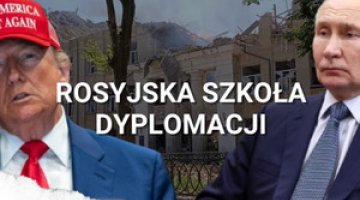Problems with Western support for Ukraine. Day 631 of the war

Russian forces are continuing to advance on the northern flank of Avdiivka; among other things, they have succeeded in driving the defenders out of the village of Stepove, although they have not taken control of it (it remains in no-man’s-land). The Russians also made advances south of the town, entering its industrial zone. To the north-west of Bakhmut, the invading forces moved towards Bohdanivka, which had already been attacked in the spring, even before the Russians occupied the city. In contrast, south-west of Bakhmut, they failed to break through the Ukrainian defences sited on the hills in the area of Klishchiivka. According to some sources, the Ukrainians made an unsuccessful attempt to strike the Russian positions between Avdiivka and Bakhmut as they attacked towards Horlivka.
Russian units also made slight advances east of Kupyansk, as did Ukrainian units south of Orikhiv in Zaporizhzhia oblast; the defenders there resumed their attacks around the villages of Robotyne and Verbove. In Krynky, on the left bank of the Dnieper, the invaders again pushed the Ukrainian forces to the centre of the village, but nevertheless the Ukrainian forces maintained their bridgehead. By contrast, the Ukrainian attempt to land on the left bank of the Dnieper, east of Kherson in the area of the Antonivka road and rail bridges, ended in failure. The situation in the other directions has not changed; the Ukrainian General Staff still identifies Marinka as the area of the Russians’ greatest activity.
On the night of 17 November, the Russians launched a massive attack on Ukraine using several groups of kamikaze drones taking off from different directions. The Ukrainian Air Force Command reported that it had shot down 9 of the 10 Shahed-136/131 drones striking from Primorsko-Akhtarsk in Krasnodar krai. Explosions caused by drone attacks were reported from Khmelnytskyi oblast. In addition, the part of Donetsk oblast controlled by the Ukrainian defenders came under attack by missiles from S-300 systems. On 16 November, at least seven Russian missiles (most likely from S-300s) struck Chuhuiv, which is the defenders’ main communications hub east of Kharkiv.
In turn, kamikaze drones attacked Odesa oblast and Starokostiantyniv in Khmelnytskyi oblast, and, according to some sources, Myrhorod in Poltava oblast; in the latter two cases, Ukrainian military airfields were the targets. The Ukrainian Air Force Command reported shooting down 16 of the 18 Shaheds used by the invaders, as well as one Kh-59 missile. On 15 November, the Russians struck Zaporizhzhia oblast with three Iskander-K cruise missiles; the village of Zarichne, where the facilities and headquarters of several Ukrainian units were located, was the most likely target here. The attack killed at least one person and wounded seven. Four enemy rockets attacked Selydove in the Pokrovsk area of Donetsk oblast on the same day. At least four people were killed and three wounded. Russian missile strikes were also reported from Kryvyi Rih and the region around Kupyansk. The Ukrainian General Staff estimated that the Russians used a total of 12 ballistic and cruise missiles on 16 November, and eight each on the previous two days.
On 16 November, Russian sources reported an attack by a Ukrainian kamikaze drone on the premises of a military unit in the village of Kotluban in Volgograd oblast, setting fire to a small arms depot. The day before, the Ukrainians attacked the Tambov Powder Factory, where a fire occurred. However, further strikes on Crimea (16 and 17 November) and the Bryansk (16 November) and Smolensk (17 November) oblasts failed. The Russians claimed to have shot down a total of eight kamikaze drones and two Neptun missiles.
On 16 November, in an interview with the AFP agency, Ukraine’s president Volodymyr Zelensky said that the supply of Western artillery munitions to Ukraine after the outbreak of fighting between Israel and Hamas had “really slowed down” and that the Ukrainian army’s stocks had decreased. He stressed that the current scale of supplies from Ukraine’s partners is too small for the country’s needs. The following day, Latvian president Edgars Rinkēvičs confirmed earlier reports that the EU would not be able to supply Kyiv with the one million artillery shells it had promised to send by spring 2024, and should therefore start purchasing ammunition from third countries. Meanwhile, Reuters reported that due to the ‘hole’ in Germany’s budget, the increase in military support for Ukraine in 2024 from the initially planned €4 billion to €8 billion, which had been announced a few days earlier, could not now be approved. For its part, the White House reported that President Joe Biden had signed a bill approved by both chambers of Congress to provide temporary funding for the work of the federal government, which did not include aid to Israel or Ukraine.
On 16 November, the Swiss State Secretariat for Economic Affairs confirmed that it was investigating media reports regarding the alleged supply of Swiss cartridges to Ukraine by the Polish company UMO. According to the Neue Zürcher Zeitung among others, there had been two instances of 145,000 sniper ammunition and 500,000 assault rifle cartridges produced by SwissP Defence entering its territory, despite the lack of approval for their re-export. On the same day, the head of the hydrographic service of the Ukrainian Navy, Roman Honcharenko, announced that Ukraine had taken delivery of an autonomous hydrographic complex (surface drone) manufactured by Maritime Robotics from Denmark.
On 14 November, President Zelensky announced that Vladimir Putin, who is planning to announce his candidacy for the presidential elections in early December, wants to declare success on the frontline by then. He added that this is evidenced by the increased intensity of Russian attacks, particularly in Donetsk oblast. At the same time, he admitted that Ukrainian forces are repelling the Russians with great difficulty. A day later, Zelensky stated that Ukraine could not afford a prolonged ‘frozen conflict’, and said that a stalemate in the fighting would threaten to exhaust the country’s human resources. On 16 November, by contrast, he said that if external financial support was reduced, the authorities might be forced to cut social benefits in order to transfer the resulting funds to the armed forces. In his view, this could trigger a social crisis, but would not mean that the fight against the invaders would stop. On the same day, in a statement to the Bloomberg agency, the Ukrainian president, citing intelligence from Ukrainian services, conveyed that the Russians wanted to implement a disinformation operation codenamed ‘Maidan 3’. Its aim is to initiate divisions in Ukrainian society and lead to anti-presidential protests.
On 16 November, Ukraine’s deputy defence minister Oleksandr Pavluk confirmed that more than 12,000 soldiers and military education lecturers had been trained under the NATO Defence Education Enhancement Programme (DEEP). He added that a proposal was being developed this year to bring Ukraine’s military educational institutions under the auspices of Alliance member states. The aim is to integrate Ukraine’s military education system with the Western military-education space.
On 15 November, the Ukrainian defence ministry reported that it supports the European Peace Facility (EFP)’s mission to monitor the disposition and use of delivered weapons and military equipment from EU countries. Representatives of the mission welcomed the Ukrainian side’s openness, and said that the monitoring programme would positively influence the EU countries’ future decisions on providing military assistance. Moreover, it will allow false accusations that military aid acquired by Ukraine has been illegally transferred to third countries or terrorist organisations to be actively countered.
On 15 November Oleksiy Danilov, the secretary of the National Security and Defence Council of Ukraine (NSDC), highlighted the need to take cyber measures to de-anonymise the channels on the Telegram messenger. He stated that the Russians are using it to spread disinformation and manipulation in an attempt to destabilise Ukrainian society. In parallel, the creation of quality Ukrainian news content should continue. At the same time, Danilov added that the network of Telegram channels administered by the 85th Main Special Service Centre (MSSC), which is subordinate to Russian military intelligence, is being used to conduct psychological operations.
On 15 November, the National Resistance Centre of Ukraine (NRCU) reported that Russian special services in the occupied territories are recruiting teenagers in studies. As part of this, ‘preventive talks’ are being held in schools during which students are warned not to take action against Russian forces or the local administration. During these talks, they are offered opportunities to co-operate with the FSB and pass on information about individuals hostile to Russia. On 16 November, the NRCU indicated that the Russians had carried out a so-called passport raid in Kakhovka in Kherson oblast. Officials went from door to door handing out applications for Russian passports to residents, taking fingerprints and handing summonses to men to appear at military commissions.
On 16 November, Ukrainian justice minister Denys Maliuska confirmed reports of plans to start construction of a second camp for Russian prisoners of war. He added that Ukraine wants to obtain international financial support for this purpose. The new camp, named ‘Zakhid-2’, will be located in Vinnytsia oblast. On 19 November, Ukraine’s Ministry for the Reintegration of Temporarily Occupied Territories reported that there are 4337 people in Russian captivity, including 763 civilians.
Commentary
- Both the Ukrainian president’s statement and the situation on the frontline indicate that the shortage of artillery ammunition is becoming increasingly acute for the Ukrainian army. On the other hand, Western representatives have confirmed the growing problems in supporting Ukraine in this field. The EU is unable to produce enough munitions on its own, while the US is currently prioritising its supplies to Israel, and its plan to increase production is only just being implemented. US manufacturers, in cooperation with a dozen or so non-US companies (including Poland), are only expected to reach their target production capacity of 90,000–100,000 rounds per month by 2025. Meanwhile, according to public estimates by various intelligence services, the Russians have increased their ammunition production to 2 million units this year, and have also acquired up to 500,000 artillery shells from North Korea. In the context of the overall Western support for Ukraine, the failure to include it in the federal executive budget’s spending plan is a negative signal. From this fund – which is currently running low – the US President has so far been assigning money for the equipment transferred to the Ukrainian army from the resources of the US Armed Forces (under the Presidential Drawdown Authority, PDA). At the beginning of November, Washington announced that the funds allocated by Congress under the Ukraine Security Assistance Initiative (USAI), the second pillar of US military aid to Kyiv, were now exhausted.
- Zelensky’s words, in which he signals concern about possible scenarios for the development of events in Ukraine, indicate that Kyiv is reckoning with the prospect of a sharp deterioration in the domestic situation. Their greatest concerns relate to a potential reduction in Western financial support maintaining the armed forces, which would force the authorities to reduce civilian spending. The increasingly difficult situation on the frontline, the lack of military success by the Ukrainian forces and the prospect of prolonged ‘trench warfare’ are factors that could negatively affect public sentiment in Ukraine in the long term.






